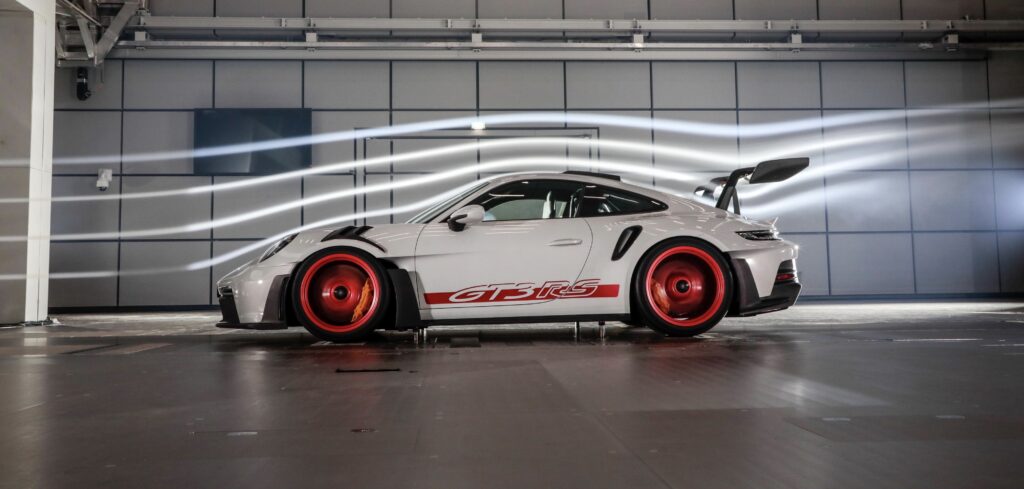The latest 911 GT3 RS from Porsche utilizes a wide range of advanced technologies and componentry from the world of motorsport to ensure the road-legal vehicle delivers the highest levels of performance and aerodynamic management.
Stepping away from the conventional three-radiator layout of previous models and drawing on an idea which was first used on the 911 RSR and eventually the 911 GT3 R, the new 911 GT3 RS now benefits from a large, centralized and angled radiator in the front end in place of the traditional luggage space. Porsche opted to make the change to ensure there was sufficient room for active aerodynamic elements at the sides of the vehicle.
Instead of having a front spoiler, Porsche opted to install a front splitter which divides air flow over and underneath the car. Additional side blades work to direct air outward. Inspired by the Le Mans-winning 911 GT1, Porsche designed the GT3 RS with inlets behind the front wheels to reduce dynamic pressure in the wheel arches. Furthermore, air from the newly positioned radiator exits from large nostril-shaped sections on the front lid. Newly installed fins on the roof direct the air outward to ensure cool air intake temperatures for the engine at the rear.
Powering the vehicle is a 4.0-liter naturally aspirated engine with a power output of 525ps, made possible through newly fitted camshafts and modified cam profiles. Drawing on components used within the motorsport sector, a single-throttle intake system and a rigid valve drive also feature. A seven-speed PDK transmission with a shorter overall gear ratio enables the 911 GT3 RS to achieve 0-100km/h in 3.2 seconds with a top speed of 296km/h.
Located at the back is a swan-neck-supported rear wing, which features a fixed main wing and a hydraulically adjustable upper wing section. This component marks the first time that the upper rear wing section has been higher than the roof on a production model Porsche.
Another first for a production Porsche vehicle is the car’s drag reduction system which enables a lower amount of drag resulting in higher speeds on straight sections of track. The large wing can be flattened by pushing a button within the cabin. When emergency braking from high speeds occurs, an airbrake function is activated where all of the aerodynamic wing elements at the front and rear are set to maximum for fast deceleration when working in conjunction with the vehicle’s brakes.
Stopping power is provided by aluminum monobloc fixed-caliper brakes with six pistons each and 408mm brake discs on the front axle. The rear axle is fitted with 380mm brake discs and four-piston fixed-caliper brakes. A larger Porsche Ceramic Composite Brake (PCCB) package can be selected with 410mm discs on the front and 390mm discs on the rear axle.
Openings in the rear side panel have also been designed to improve aerodynamics and to not to draw in process air. The rear wheel arch also benefits from an intake and a side blade for better airflow.
With 911 GT3 RS’s wheel arches being subject to powerful airflows, the double-wishbone front axle suspension has been designed in a teardrop-shaped profile. These work to increase overall downforce on the front axle by approximately 40kg when the car is traveling at its top speed.
All of the aerodynamic components, adjustable wing elements in the front and the two-part rear wing combine to deliver 409kg of total downforce at 200km/h – twice as much as its 991.2-generation predecessor and three times as much as a current 911 GT3. Total downforce is 860kg at 285km/h.
Three driving modes consisting of Normal, Sport and Track can be selected depending on the driving scenario. When in Track mode settings including the rebound and compression damping of the front and rear axles can be adjusted using rotary controls on the steering wheel for optimal handling on different race circuits. The rear differential can also be adjusted in the same way.
By utilizing a wide range of CFRP for the doors, front wings, roof and front lid, the 911 GT3 RS has an overall weight of 1,450kg.



